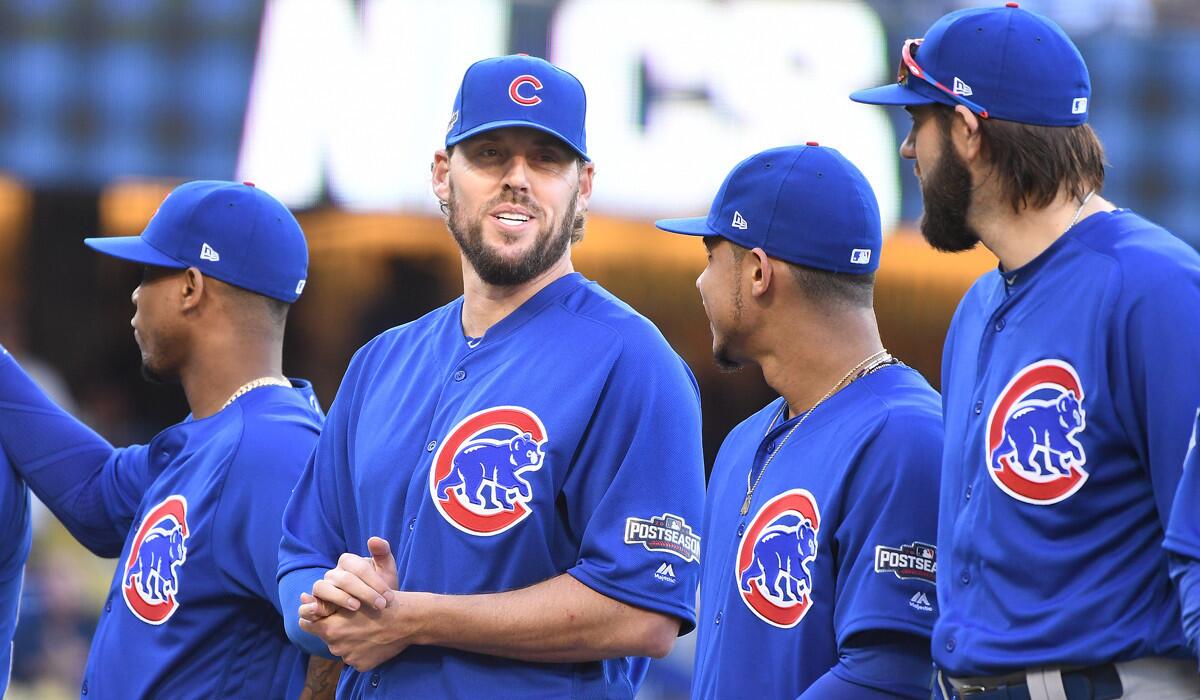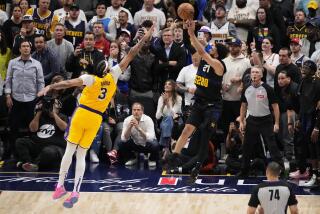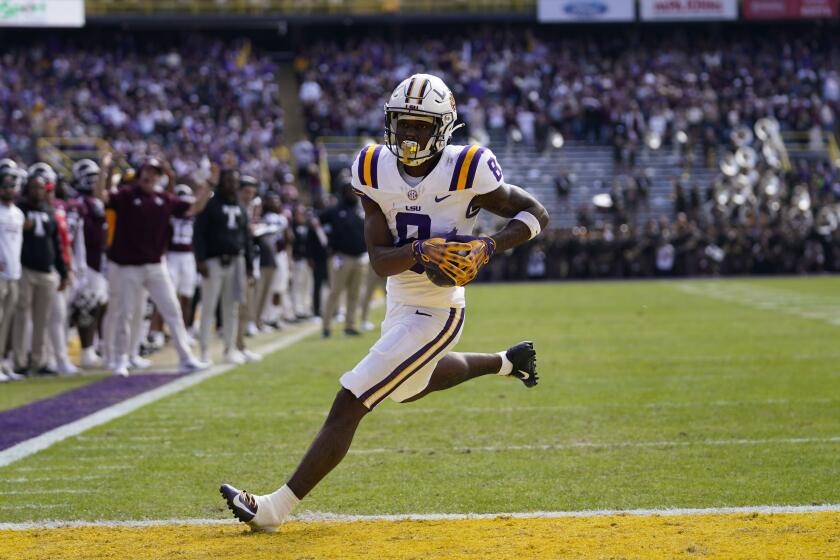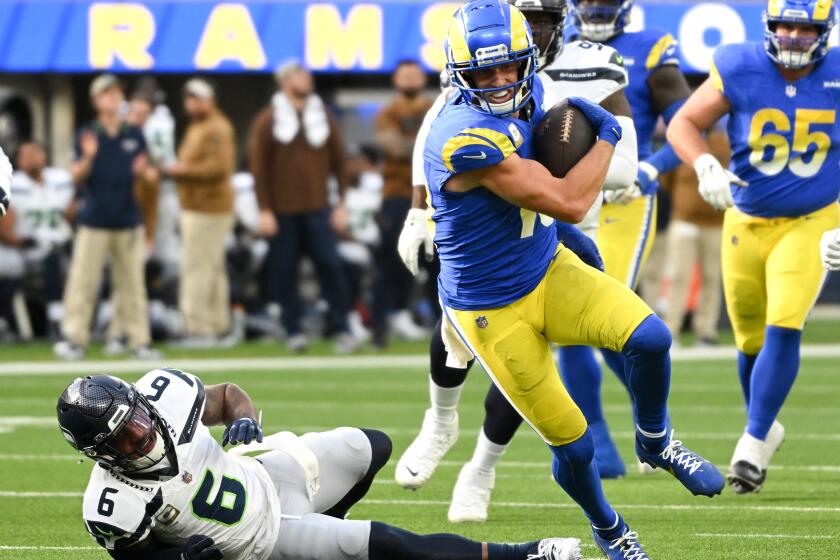Cubs’ John Lackey has plenty of experience and passion to make another postseason start

Chicago Cubs Manager Joe Maddon describes the ultra-competitive John Lackey as “a cowboy when he pitches,” and as the veteran right-hander and Texas native has said many times during his 14-year big league career, this ain’t his first rodeo.
When Lackey, who turns 38 on Sunday, takes the mound for the Cubs in Game 4 of the National League Championship Series on Wednesday, it will be his 22nd postseason start.
Lackey has notched two World Series-clinching victories, in Game 7 as a rookie for the Angels in 2002 and Game 6 for the Boston Red Sox in 2013, and he has an 8-5 record and 3.22 earned-run average in 131 1/3 career postseason innings.
His mound opponent Wednesday will be Julio Urias, the Dodgers left-hander who turned 20 on Aug. 12 and will be the youngest pitcher in major league history to start a postseason game.
Advantage, Lackey? Not necessarily.
“Sometimes it can be good to be young,” said Lackey, who had just turned 24 when he started the 2002 World Series clincher. “You don’t know what you’re getting into. You can just go out there and let your talent take over, and obviously, [Urias] has a lot of that.
“It’s a new situation for him. Back [in 2002] I was just worried about, you know, not messing it up for the older guys more than anything.”
Lackey did not mess anything up against the San Francisco Giants on that late October evening in 2002. He allowed one run and four hits in five innings before yielding to the bullpen trio of Brendan Donnelly, Francisco Rodriguez and Troy Percival, laying the foundation for a 4-1 victory that enabled the Angels to hoist their only championship trophy.
A mid-season addition to the Angels that season, Lackey went on to pitch for five more Angels playoff teams from 2004-2009, a Red Sox World Series team (2013), two St. Louis Cardinals playoff teams (2014-2015) and now a Cubs playoff team that is looking to end a 108-year World Series championship drought.
Winning Game 7 of a World Series as a rookie “definitely set the bar pretty high to start with, I guess,” Lackey said. “Handling big situations has never been a huge deal for me because I kind of started there.”
While Urias admitted Tuesday that the pressure of his first playoff start will be “something I’ll have to deal with,” Lackey shouldn’t have any problems channeling his adrenaline.
His playoff experience will help “with the stuff outside the game … that you don’t have to do in the regular season,” said Lackey, who went 11-8 with a 3.35 ERA in 29 starts this season after signing a two-year, $32-million deal with the Cubs in December.
“If you’re pitching on a day when there are flyovers and the extra time between innings, just knowing how to handle those sorts of things and kind of slowing the moment down a little bit.”
As much as Urias has impressed Maddon, the Cubs manager likes Lackey’s savvy in what could be a pivotal game in the best-of-seven series.
“You could always say that what you don’t know can’t hurt you — you just go out there and you’re winging it and you’re not over-analyzing it; I get that,” Maddon said. “But having an experienced guy like John … he really understands what he’s doing out there and how to manipulate and work against certain hitters.
“He knows how to use a hitter’s aggressiveness against him. He knows who to stay away from in certain moments. He’ll pick his poison, who to pitch to and who to not pitch to. He has a really good feel for this part of the game.”
Maddon was the Angels’ bench coach in 2002. Asked how Lackey has changed from then to now, he said, “Honestly, he hasn’t changed at all.”
The 6-foot-6, 235-pound Lackey relies on the same fastball-slider-curve-changeup mix he came up to the big leagues with. He mechanics and delivery haven’t changed.
Despite missing 2012 because of elbow ligament-replacement surgery, the average velocity of Lackey’s fastball has remained between 90.4 mph and 91.7 mph since 2003, a variance of just 1.3 mph.
Lackey’s WHIP (walks plus hits per inning) of 1.057 this season was well below his career WHIP of 1.296, and his 8.6 strikeouts per nine innings matched his career high, set in 2005.
“He’s actually in better shape physically — compare the pictures from 2002 to how he looks now,” Maddon said. “He’s taking care of himself.
“Stuff-wise, his gun ratings are similar. He goes right after hitters. … His stuff is absolutely there. The attitude is there. I know he’s going to be ready for the moment.”
mike.digiovanna@latimes.com
Twitter: @MikeDiGiovanna
More to Read
Get our high school sports newsletter
Prep Rally is devoted to the SoCal high school sports experience, bringing you scores, stories and a behind-the-scenes look at what makes prep sports so popular.
You may occasionally receive promotional content from the Los Angeles Times.







